Journey Orchestration Engines Best Practice Guide
An introduction to journey orchestration
A customer journey is the sum of every interaction that a customer has with your brand. It starts from the first moment they see your ad, through the point of transaction and post-purchase in terms of customer experience and follow up activities.
Customer journey orchestration bridges the gaps between teams and touchpoints to actively manage the customer journey. The process links what once were disconnected interactions into a series of compelling interactions. The goal is to improve the customer’s experience of the brand, not just the product. Journey orchestration helps build customer engagement and loyalty.
For B2B and B2C marketers however, the customer journey has become increasingly complex. This complexity, plus the need to provide great customer experiences across channels and touchpoints, is what’s driving the push for better journey orchestration tools.
The pandemic changed the way consumers shop and shifted people’s priorities in ways that are likely to remain permanent. The path customers take from consideration to purchase is no longer a funnel or a straight line. It’s a circuitous multi-touchpoint, multi-interaction quest that finds your customers offline as much as they are online.
Figure 1: The modern omnichannel customer journey (1)
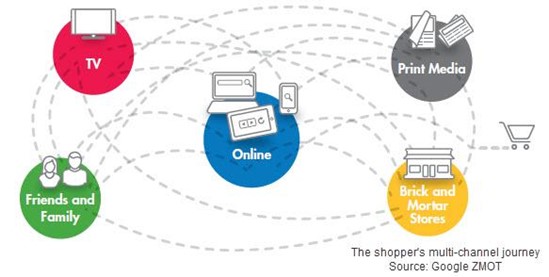
Understanding and optimising today’s uber-connected, multiple touchpoint customer journey requires businesses to track and analyse every interaction that a customer has with your brand before and after they transact.
And while the breadth and shape of the customer journey is a constantly moving target, many pandemic-inspired consumer behaviour trends are likely here to stay.
Multiple studies indicate that there has been unprecedented growth in global online sales in the last two years. This growth continued even as vaccine rollouts gained momentum and consumer confidence in the safety of in-person engagements lagged. (2)
The at-home economy is also enduring. Consumers continue to prioritise spending on home-focused items and experiences like cooking from scratch, subscribing to digital services, and eating at home.
Journey orchestration focuses on meeting shoppers and customers wherever they happen to be. This means that marketers must be able to stitch data together from multiple sources, measure the business impact of that data, and orchestrate the best experience possible for their customers.
This means that marketers need to gain a deeper understanding of customer journeys to be able to use journey orchestration successfully. This can mean abandoning traditional linear journey maps in favour of more realistic ways of viewing customer behaviour to find the points where marketers can optimise the journey or aid in the decision making process
What is a journey orchestration engine?
A journey orchestration engine (JOE) is a piece of marketing technology that can combine real time customer analytics with real-time decisioning to deliver communications informed by the customer’s needs, whatever the channel or touchpoint. In this sense, a JOE provides the ability to orchestrate personalised journeys for customers based on available data.
Essentially, JOEs enable marketers to manage and curate the customer journey, rather than managing channels in isolation. It looks at certain processes and actions that worked on other prospects - and ultimately turned them into customers - and then suggests them to similar-minded prospects who have not yet been swayed.
The goal of a JOE is to create exceptional customer experiences at the individual customer level, communicating the right message at the right time and in the right channel.
What JOEs do: JAMM
JOEs excel at three critical capabilities; Journey Analytics, Journey Mapping and Journey Management (JAMM).
Figure 3. Customer journey management illustration
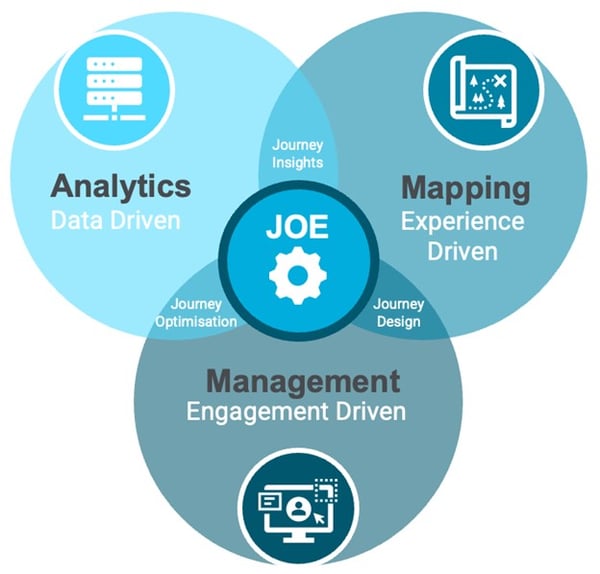
- Journey Analytics: Best-of-breed JOEs have measurement capabilities that monitor and report on all aspects of the customer journey. They measure how each individual customer interaction can impact a transaction, enabling marketers to understand the link touchpoints and performance.
Journey analytics can expose potential friction points in the customer journey and opportunities for improvement.
- Journey Mapping: A journey map tells a visual story of each interaction that a customer has with your brand. Journey mapping tools collect data from multiple touchpoints in the customer journey. They use this data to create a “map” of how your customer interacts with your brand, and how each interaction and channel works together to support your goals. There are two main modes of customer journey mapping:
- Current state maps are used in diagnostic phases to identify common customer pain points or opportunities to improve the customer journey.
- Future state maps create a vision of the ideal journey, free from the limitations of departmental silos, people or technology problems. It does that by allowing marketers to address the pain points in the current state map by orchestrating more streamlined customer journeys.
Figure 2: Example of a journey map for a customer shopping for a dress.
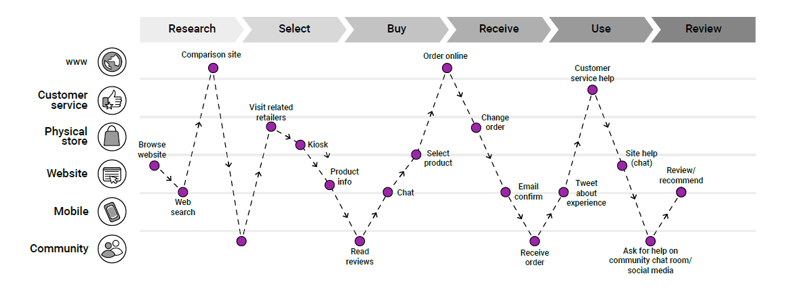
- Journey Management: JOEs use maps and analytics to help marketers influence the customer journey by using real-time customer data to analyse current behaviour and predict and adjust future behaviour in the moment to optimise customer journeys. T
AI and machine learning have a role to play in journey orchestration. JOEs use predictive models that optimise digital experiences as customers shop. These models incorporate real-time customer analytics such as customer, behavioural and transactional data to orchestrate communications, interfaces and offers throughout the customer journey in order to optimise transactions, retention and business goals.
“JOEs connect engagement, behavioural and historical data to analyse, map and optimise the entire customer journey. This leads to more efficient and effective marketing management rather than optimising touchpoints or channels in isolation.” - Carlos Doughty, CEO, MarTech Alliance
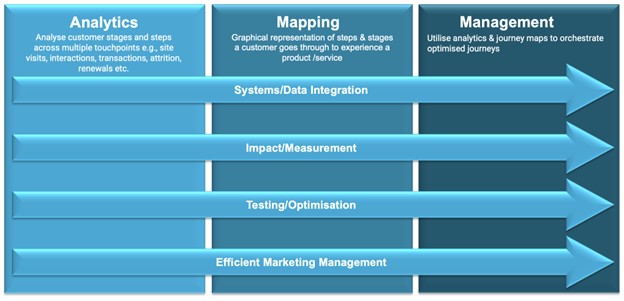
How JOEs work (SITE)
- Systems/data integration: JOEs integrate data from disparate systems, platforms, and vendors including legacy systems. This exposes every part of the customer journey, enabling marketers to understand and optimise the end to end customer experiences.
- Impact/measurement/analytics: A key function of a JOE is its ability to monitor and measure how journey improvements impact your business. This enables you to tie steps of the journey to specific KPIs—data that can be used to optimise the journey through automated alerts and recommendation
- Testing & optimisation: JOEs use comprehensive journey data to test the potential impact of journey improvements before rolling them out to all customers. Testing can be applied to evaluate different journey scenarios and their impact on KPIs before scaling out.
- Efficient marketing management: JOEs help you orchestrate better customer journeys by alerting you to relevant insights. They use real-time customer behaviour to develop predictive models which optimise current and future experiences. By incorporating data sources like CRMs and CDPs to optimise journeys over the entire customer lifecycle, they can also facilitate more efficient and effective marketing strategy and execution.
It’s possible to categorise JOE advantages from the point of view of the marketer and the customer.
Advantages of JOEs for Marketing Management
Facilitate business transformation
JOEs help companies manage the many moving parts inherent in the modern customer journey, stitching together different marketing systems, platforms, channels, and initiatives. They allow different teams to understand how their programs and projects impact everyone involved in the customer journey—from product development teams to marketing to sales to customer service.
Journey orchestration engines eliminate siloed marketing management and inconsistent customer experiences by stitching customer data from multiple touchpoints together. A by-product of clarity around the customer journey is the ability to restructure marketing functions to optimise the customer journey and manipulate channel activity accordingly rather than having teams that focus on optimising channels in isolation.
Remove organisational silos
Effective journey orchestration requires multi-team communication and coordination. JOEs remove organisational silos, connecting different pieces of your customer experience tech stack so that everyone’s accessing the same information.
This allows different teams—product, marketing, customer service, sales—to understand the customer journey outside of their own individual bubbles. Removing silos not only reveals stumbling blocks along the customer journey, but it helps ensure that all teams work together to achieve common goals.
Improve journey visualisation
Eliminate data and system silos so you can visualise every aspect of the customer journey.
- Understand your customers’ buying experience (versus your understanding of that experience).
- Eliminate blind spots by connecting all points of the customer journey (which can then be communicated to all teams involved in creating that journey).
Improve journey optimisation
JOEs assume that each individual experience contributes to the whole, so tweaking one step in the journey may have consequences for another step, or for the entire journey.
- Identify friction points within and across the customer journey so they can be improved/optimised.
- Create predictive models based on customer journey mapping which helps make your buyer personas more accurate (and customer interactions more effective).
- Positively impact the holistic customer experience, making customers happy, and ultimately reducing costs and improving revenue.
Improves efficiency and effectiveness of marketing activities
The ability to analyse and quantify each customer interaction so you can understand what impacts your customers (and company) the most.
Advantages of JOEs for customer experience
Journey orchestration takes mapping to the next level by making positive changes that improve user experience, optimise design elements, and ensure the customer’s interactions are streamlined (and appropriate) across the journey lifecycle.
Since a JOE’s inherent benefits include scalability and omnichannel integration, they help you keep the customer experience consistent over time across the entire journey.
Identify & resolve experience roadblocks
The process of journey mapping requires you to navigate and document all customer interactions and touchpoints. Mapping is a necessary component of journey orchestration. It shows how systems, initiatives, data, and people are connected, but it also shows the opposite—where you lack sufficient support or information within the journey.
It provides transparency and insight about what customers are experiencing and helps set the stage for the changes you need to positively impact the journey.
Personalise experiences across channels
Successful customer journey orchestration seeks to achieve peak personalization—customising each individual customer’s journey across every channel. JOEs move away from personalising each separate experience, instead focusing on the interactions that are most relevant in the context of the entire buying journey.
Journey orchestration seeks to improve business outcomes by making customers happy. Increasingly, that means delivering highly personalised customer experiences.
Deliver customised experiences at scale
Ah scalability, the gleaming unicorn of the martech world. Delivering consistently good experiences across a menu of ever-changing channels at the individual customer level is challenging.
JOEs enable you to optimise the end-to-end customer experience by using the magic bullet of martech—machine learning and AI. Platforms leverage ML and AI models to make “next best” action recommendations based on a customer’s past interactions. Journey orchestration tools manage customer interactions across channels in real time, pull data from multiple sources and systems, and use decisioning technology to orchestrate individualised journeys at…you guessed it…scale.
Considerations when selecting a JOE
Strategy
It’s not a magic bullet. JOEs can help you connect the dots of your customer’s journey, but you’ll also need team collaboration, time, and a commitment to changing legacy systems and processes to effectively optimise the customer experience.
Process considerations
JOEs require a significant investment in time and money. Integrating systems, data, and experiences into a connected approach takes time. It also means multiple teams must be involved in planning, execution, and usage of the tool (which requires training and ongoing communication).
The perfect journey is a moving target
JOEs can help you optimise your customers’ journeys – up to a point. There are an infinite number of ways customers get from point A to point Z and JOEs can’t account for everything (but, as a whole, they can improve things like revenue, sales, and customer loyalty).
Why do I need a journey orchestration engine? / The business case for JOEs
Journey orchestration equals happier customers which equals more revenue. A report by BCG notes that companies who adopt what they call a “customer journey-at-scale” approach can see revenue increases of 10% to 20%. (3)
Journey orchestration also improves customer advocacy by 20% to 40% and can help companies achieve cost reductions between 15% and 25%. (3)
Where JOE sits in the tech stack
JOEs help you create a unified customer experience, but so do a lot of other technologies. That makes answering the question, “Where do JOEs sit in the tech stack?” a bit tricky. The short answer is: they’re part of your technology foundation, right up there with CDP, data warehouse, and marketing cloud (or, at least, we predict they will be).
Pureplay JOEs are considered an emerging technology. Kitewheel, Usermind, Thunderhead, Alterian, Pointillist, and NICE are some of the major firms in this space, though the landscape continues to shift.
JOEs help align and streamline the tech that’s already in your stack. They support and connect the hybrid and CXM technology that works together to create seamless customer experiences.
Figure 4: MarTech Alliance’s hybrid tech & CX stack
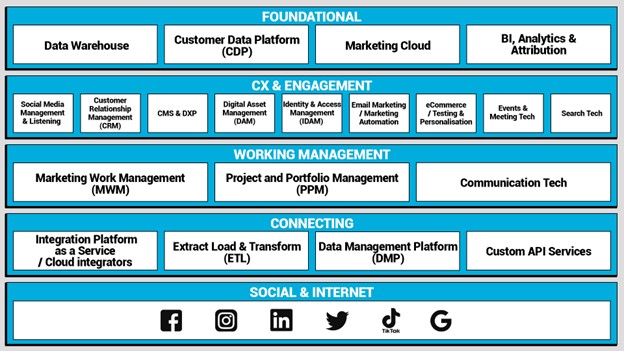
In our 2021/22 Martech Report, JOEs landed at the bottom of the list of martech tools that businesses had added in the past 12 months. (4)
Figure 5: Major martech tools UK organisations plan to add in the next 12 months (4)
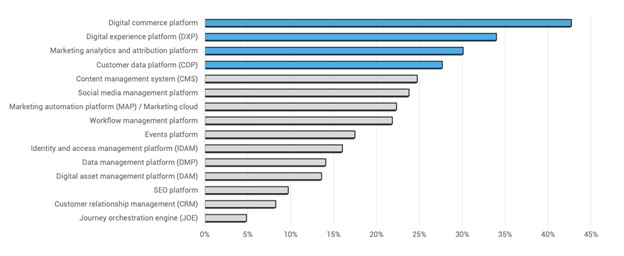
JOEs landed a few spots higher on the list of martech tools that organisations added to their stack in the past 12 months.
The fact that they’re so new to the martech landscape combined with some inherent overlap with other tools (we’re looking at you, digital experience platforms) is likely the reason for this.
Figure 6: Major martech tools UK organisations added in the next 12 months (4)
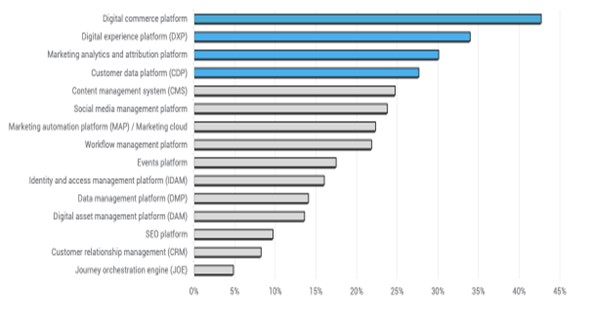
How do I choose a Journey Orchestration Engine?
The JOE landscape is an ever-changing one. Vendor websites contain a wealth of information, with the caveat that is naturally very complimentary of the vendor’s offerings.
Map your use cases
Different use cases lend themselves to different solutions. When considering a JOE, we suggest you look at common business use cases and apply them to your own unique scenario.
Regardless of the use case, it’s important to keep the main benefits in mind before making the final decision about what technology is right for you.
Use Case #1: Digital customer acquisition
|
Improve customer acquisition across digital channels. |
● Connect and track acquisition journeys on all digital channels. ● Optimise digital interactions to align with individual customer goals and behaviour. ● Increase revenue/acquisition by aligning channel messaging and offers (upsell/cross-sell). ● Understand the causes for churn and prioritise/optimise actions across the journey to limit it. |
Use Case #2: Offline/online customer acquisition
|
Improve customer acquisition across offline and online channels. |
● Connect offline and online customer experiences. ● Merge/fuse data across channels including offline touchpoints (e.g., in-store, sales meetings, etc.) ● Align customer-facing teams so they can provide consistent messaging and experiences online and offline. ● Ensure the customer is “known” regardless of whether the interaction occurs online or offline. ● Route sales to appropriate online or offline channels based on real-time customer interactions. |
Use Case #3: Sales enablement.
|
Empower B2B and B2C sales teams to sell more by optimising the customer journey. |
● Deliver coordinated cross-channel marketing campaigns. ● Provide the appropriate content/information in the context of an individual customer’s journey. ● Orchestrate marketing-to-sales handoff more intelligently (e.g., lead routing). ● Connect sales tools to the buying journey ecosystem so sales and marketing teams are on the same page. |
Use case #4: Channel partner orchestration.
|
Align the most appropriate channels to the most relevant customer interactions. |
● Effectively integrate digital and traditional channels. ● Leverage customer channels and interaction preferences along the entire journey continuum. ● Improve the overall quality of the customer experience. ● Reduce acquisition costs. ● Employ AI/ML to optimise channel selection/messaging at scale. |
Use case #5: Revenue optimisation and retention.
|
Improve revenue and retention by being more customer centric. |
● Deliver more value to customers while reducing overall costs. ● Understand customer goals and optimise journeys to help customers meet them. ● Keep customers satisfied and motivated to return/remain. ● Link customer behaviour to business outcomes by understanding how buying journeys impacts revenue. |
Use case #6: Improve cross-channel service and support.
|
Improve customer service across online and offline channels. |
● Align offline and online support teams so they understand why customers seek support across different channels. ● Give call centre agents the ability to see customer history/interactions outside of the contact centre. ● Reduce call time and/or number of calls by providing customers with appropriate information and support along the journey. ● Use journey monitoring over time to improve internal customer service processes and better address common pain points and issues. |
For each of your business use cases you will want to document specifically what you want a JOE to help solve. Below is a framework that may help.
|
Business use case area |
As a <type of user> |
I want <some goal> |
So that <some reason> |
|
Increase eCommerce sales from first-time shoppers who are hesitant to complete a sale. |
Marketer |
Guide customers to resources/information on our eCommerce website that creates confidence in a first-time purchase. |
Reduce cart abandonment rates for new customers and create an impactful first-impression. |
You can make the above framework more relatable by telling a meaningful story, as follows.
Talia, our Digital Sales Director, is frustrated with the high cart abandonment rate from first-time shoppers on her company’s ecommerce website. She wants to improve the overall customer shopping experience by presenting new customers with compelling content that 1) reduces purchase hesitation and 2) motivates them to complete their purchase after adding items to their cart, and 3) leaves them with a positive first shopping experience.
Talia wants to use a journey orchestration engine to identify new users as they shop on the website and serve relevant content that guides them to complete their purchase (e.g., coupons, social proof, customer service bots, etc.)
She wants these interactions to be customised for each customer journey, with the website reacting in real-time as the customer shops. Her goal is to reduce cart abandonment and increase revenue from sales without increasing her organisation’s costs.
Defining your use cases is key to your RFI/RFP documents proving meaningful to headless/hybrid CMS vendors. This will allow them to understand your exact requirements and showcase how their solution can play this out when they demo their platform vs providing a generic overview of capabilities.
Create a vendor scorecard
Creating a vendor scorecard to evaluate each vendor is the next step. That way you can take a systematic approach to assessing products.
Creating a scorecard involves being clear on your use cases so that you can evaluate whether there is the functional fit between your requirements and the vendor product. You might also need to evaluate architectural fit to understand what technical support is required to manage integration with existing tools. Beyond business use cases and technical architecture, you also need to assess what kind of training and support the vendor will provide.
We’ve created this basic scorecard with suggested weightings to get you started. It doesn’t cover everything but our Essentials of Marketing Technology contains a much more detailed worksheet to help you evaluate vendors as well as a comprehensive guide to help you with the process of vendor selection.
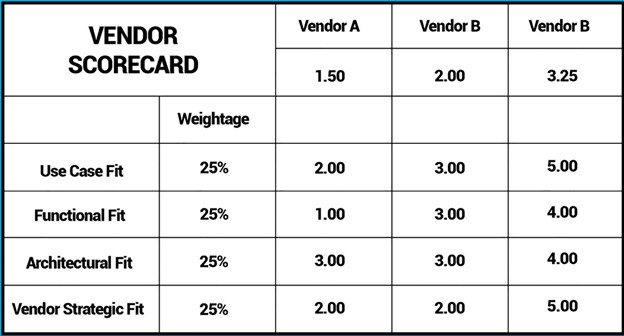
With your use cases documented, vendor scorecard defined, and RFI/RFP created,
it’s time to start connecting with vendors.
Creating a short list based on your company profile and preference is a good starting point; JOE capabilities and ratings, B2B or B2C focus, functional specialism, industry and company size match.
As you progress to chatting with vendors, we would recommend you:
- Take your time & prepare – Don’t rush the process. Make sure you have done your research to better understand the JOE space. Ensure you have details of your journey orchestration needs available and your vendor scorecard and questions.
- Run a custom demo – Make sure vendors have your business use cases and business background weeks before your demo so they can sufficiently prepare and tailor what they present so you can make a fair assessment.
- Get into the detail of your expectations around journey orchestration and how that influences customer experience. Get into the nuts and bolts of your needs/goals to really assess the ease, speed and cost of getting a JOE in place.
- Review vendor case studies – Ask for customer case studies showing key results of their platform.
- Assess direct and indirect vendor costs – Ensure you get all costs from vendors from data hygiene and onboarding, custom integrations, consulting, training and any other area beyond the platform licensing itself. If the vendor doesn’t cover all areas, ensure you have forecast what additional investment is needed. This could be consultancy to manage your content modelling or an internal new hire such as a lead developer to be the platform super user.
- Get vendor customer references – and ideally direct access to chat with some of their clients.
Summing Up
Customer Journey Analytics, a key functionality of JOEs, is a growing market that’s projected to reach over $25 billion globally by 2026. JOEs provide three key capabilities: journey analysis, mapping and management that, combined, help marketers adapt to changing consumer expectations, behaviours, and needs.
- Journey analytics combines data from multiple touchpoints and channels.
- Journey mapping helps companies visualise the buying journey from their customer’s perspective.
- Journey management uses this information to craft personalised, relevant journeys that are contextually relevant for each customer.
Customers value experience more than brand, product, and company. Research suggests that they will pay up to 16% more for products or services when they feel appreciated and known. This is true across almost all industries, with certain industries like travel, health, and retail benefiting the most. Even more compelling – over 30% of all customers will stop doing business with a brand they love after just one bad experience.
JOEs help companies understand how each customer interaction impacts the entire journey, enabling you to improve the customer journey and make every moment count.
Citations
- Source, thinkwithgoogle, ‘ZMOT Handbook’, thinkwithgoogle, 2018. (https://www.thinkwithgoogle.com/_qs/documents/705/2012-zmot-handbook_research-studies.pdf)
- Source: Deloitte, ‘Retail Trends 2022’, Deloitte, 2022. (https://www2.deloitte.com/uk/en/pages/consumer-business/articles/retail-trends.html)
- Source: Bharat Poddar, Yogesh Mishra, and Anandapadmanabhan Ramabhadran, ‘Transform Customer Journeys at Scale—and Transform Your Business’, BCG, November 8, 2019. (https://www.bcg.com/en-gb/publications/2019/transform-customer-journeys-scale-transform-business)
- Source: MarTech Alliance / Moore Kingston Smith, ‘The Martech Report 2020/2021’ MarTech Alliance, October 2021. (https://www.martechalliance.com/martechreport)
- Source: Markets & Markets, ‘Customer Journey Analytics Market’, Markets & Markets, 2021. (https://www.marketsandmarkets.com/Market-Reports/customer-journey-analytics-market-119398916.html)
- Source: Deloitte, ‘Retail Trends 2022’, Deloitte, 2021. (https://www2.deloitte.com/uk/en/pages/consumer-business/articles/retail-trends.html)
- Source: Bharat Poddar, Yogesh Mishra, and Anandapadmanabhan Ramabhadran, ‘Transform Customer Journeys at Scale’. BCG, November 8, 2019. (https://www.bcg.com/en-gb/publications/2019/transform-customer-journeys-scale-transform-business)
- Source: CSG: ‘Csg Supercharges Customer Engagement Solutions With Acquisition of Kitewheel’, July 14, 2021. (https://ir.csgi.com/investors/press-releases/press-release-details/2021/CSG-Supercharges-Customer-Engagement-Solutions-with-Acquisition-of-Kitewheel/)
